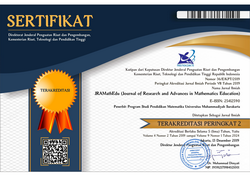Students' Mathematical Communication Ability through the Brain-Based Learning Approach using Autograph
Mailis Triana(1*), Cut Morina Zubainur(2), Bahrun Bahrun(3)(1) Master Student in Mathematics Education, Syiah Kuala University
(2) Mathematics Education Department, Syiah Kuala University
(3) Early Childhood Education Department, Syiah Kuala University
(*) Corresponding Author
Abstract
AStudents’ skills in expressing mathematical ideas in various ways have not met the expectation. Teachers need to apply the learning providing students’ opportunities to present their mathematical ideas. Utilizing the Brain-Based Learning (BBL) approach with Autograph can help students develop their mathematical communication skills. The purpose of this study was to analyze the development of students’ mathematical communication skills. Twenty-eight 10th grade students in one of the high schools in Banda Aceh participated in the study. The instruments used were a mathematical communication skills test and the activity observation. Data were analyzed using descriptive analysis. The study showed that mathematics learning applying BBL approach with Autograph contribute to developing students’ mathematical communication skills.
Keywords
Full Text:
PDFReferences
Astuti, A., & Leonard, L. (2015). Peran Kemampuan Komunikasi Matematika Terhadap Prestasi Belajar Matematika Siswa. Formatif: Jurnal Ilmiah Pendidikan MIPA, 2(2), 102–110.
Bakar, K. A., Ayub, A. F. M., & Tarmizi, R. A. (2010). Utilization of computer technology in learning transformation. International Journal of Education and Information Technologies, 4(2), 91–99.
Camacho, M., Depool, R., & Santos-Trigo, L. M. (2004). Promoting Students Comprehension of Definite Integral and Area Concepts Through the Use of Derive Software. Proceedings of the 26 PME-NA, 2,447-454.
Chung, Y., Yoo, J., Kim, S.-W., Lee, H., & Zeidler, D. L. (2016). Enhancing students’ communication skills in the science classroom through socioscientific issues. International Journal of Science and Mathematics Education, 14(1), 1–27.
Degen, R. (2014). Brain-Based Learning: The neurological findings about the human brain that every teacher should know to be effective. Amity Global Business Review, 9, 15–23.
Duman, B. (2006). The Effect of Brain-Based Instruction to Improve on Students, Academia Achievement in Social students Instruction. 9yh Internationa Conference on Engineering Education, 24(1),17-25.
Gordah, E. K., & Astuti, R. (2013). Meningkatkan Kemampuan Komunikasi Matematis Mahasiswa Melalui Pengembangan Bahan Ajar Geometri Dasar Berbasis Model Reciprocal Teaching di STKIP PGRI Pontianak. In Makalah disajikan pada Seminar Nasional Matematika dan Pendidikan Matematika, Universitas Negeri Yogyakarta, 9(2), 227-232.
Gozuyesil, E., & Dikici, A. (2014). The Effect of Brain-Based Learning on Academic Achievement: A Meta-Analytical Study. Educational Sciences: Theory and Practice, 14(2), 642–648.
Hasibuan, N. H. (2016), Pemanfaatan Autograph sebagai Media Pembelajaran Matematika dengan Menerapkan Model Pembelajaran Berbasis Masalah. Cahaya Pendidikan. 2(1), 34-46.
Hasliza, A., Emilin, W. (2012). New Way to Learn, New Way to Succes: Transforming a Brain-Based Library Via Active Learning Instructions. Proceeding of the IATUL Conferences.
Hutagaol, K. (2013). Pembelajaran kontekstual untuk meningkatkan kemampuan representasi matematis siswa sekolah menengah pertama. Infinity Journal, 2(1), 85-99.
Jensen, E. (2008). Brain-Based Learning: Pembelajaran Berbasis Kemampuan Otak. (Terjemahan Narulita Yusron). Yogyakarta: Pustaka Belajar.
Muhammad, I., Nufus, H., Mursalin (2017). Penigkatan Kemampuan Komunikasi Matematika Melalui Pembelajaran Kooperatif Tipe STAD Berabsis IC. Jurnal Kajian Pembelajaran Matematika. 1(2), 113-118.
NCTM. (2000). Principle and standards for School Mathematics. USA: NCTM.Inc.
NCTM. (2008). Principles and Standards for School Mathematics. Virginia: NCTM.
Ozden, M., & Gultekin. (2008). The Effect to Brain-Based Learning on The Academic Achievement and Retention of Knowledge in Science. Electronic Journal of Science Education. 12(1), 2-9.
Permendikbud No. 022. (2016). Standar Proses Pendidikan Dasar dan Menengah. Jakarta: Menteri Pendidikan dan Kebudayaan Republik Indonesia.
Rasyidah, A., Marzal, J., & Damris, M. (2015). Investigasi Pengetahuan, Keterampilan dan Implementasi Teknologi Informasi dan Komunikasi (TIK) Guru Matematika SMA/MA Di Kabupaten Tanjung Jabung Barat. Edu-Sains, 4(2), 37-45.
Sanapiah. (2015). Peran Penggunaan Ilustrasi Visual dalam Meningkatkan Kemampuan Pemecahan Masalah Matematika Siswa SMP. Jurnal Kependidikan, 14(3), 265-274
Sanjaya, W. (2010). Kurikulum dan Pembelajaran. Jakarta: Kencana.
Saragih, S., & Afriati, V. (2012). Peningkatan Pemahaman Konsep Grafik Fungsi Trigonometri Siswa SMK melalui Penemuan Terbimbing Berbantuan Software Autograph. Jurnal Pendidikan Matematika, 18(4), 367-381.
Sinurat, M., Syahputra, E., & Rajagukguk, W. (2015). Pengembangan Media Pembelajaran Matematika Berbantuan Program Flash untuk Meningkatkan Kemampuan Matematik Siswa SMP. Jurnal Tabularasa PPS Unimed, 12(2), 154-170.
Sukoco, H., & Mahmudi, A. (2016). Pengaruh Pendekatan Brain-Based Learning terhadap Kemampuan Komunikasi Matematis dan Self-Efficacy Siswa SMA. Journal Pythagoras, 11(1), 11-24
Syarifah, T. J., Ponco, S., Rubono, S., (2017). Analisis Kemampuan Komunikasi Matematis Tertulis Ditinjau Dari Gaya Belajar Pada Siswa Kelas 9oXI MIPA 1 SMA Batik 1 Surakarta Tahun Pelajaran 2015/2016. JPMM, 1(2), 1-19.
Syarwan, R., Mukhni., Murni, D. (2014). Pengaruh Pendekatan Brain Based Learning(BBL) terhadap Kemampuan Penalaran Matematis Siswa Kelas VII SMP Islam Raudhatul Jannah Payakumbuh. Jurnal Pendidikan Matematika, 3(1), 29-34.
Utami, C. (2015). Pembelajaran Model Generatif dengan Strategi Group Investigation untuk Meningkatkan Kemampuan Komunikasi Matematis Siswa. Unnes Journal of Mathematics Education Research, 4(1), 18–25.
Viseu, F., & Oliveira, I. B. (2012). Open-ended tasks in the promotion of classroom communication in Mathematics. International Electronic Journal of Elementary Education, 4(2), 287–300.
Zayyadi, M., Supardi, L., & Misriyana, S. (2017). Pemanfaatan Teknologi Komputer sebagai Media Pembelajaran pada Guru Matematika. JPMB (Jurnal Pengabdian Masyarakat Borneo), 1(2), 25–30.
Article Metrics
Abstract view(s): 3641 time(s)PDF: 2613 time(s)
Refbacks
- There are currently no refbacks.







